texasmonthly.com: Texas Monthly has covered the Texas Rangers before, most notably in the February 1994 cover issue. Why is this particular story important to tell, especially as the cover story again?
Pamela Colloff: We felt that it was time to revisit the Rangers. The last time they were the focus of a story, women had just entered the force, and many older Rangers were retiring and on their way out. AFIS and DNA technology were just starting to become important tools for investigators. The landscape has changed pretty dramatically since 1994, so we wanted to see what had happened to the Rangers since we last wrote about them. We put the Rangers on the cover because they make up one of the oldest and most iconic institutions in Texas.
texasmonthly.com: There’s a lot you didn’t use for this story. Why did you decide to use what you did?
PC: You’re right—there was an enormous amount of material that I didn’t get to use, but that is true for every story. I was limited by the space that was available in the magazine, but that is a good thing: Those limitations force a writer to make hard choices and pick the very strongest material that she or he has. Carving a narrative out of material that is gleaned from, say, forty interviews is one of the hardest things about writing a feature story, and it can be especially hard with an oral history. This story did not have a natural narrative with a beginning, middle, and end, so I picked quotes that highlighted the theme of the piece: how the Rangers have changed, and not changed, in the modern world.
texasmonthly.com: What was something you wish you could have added, if you had the space? A certain case from one of the rangers? A story of older Rangers?
PC: There were dozens and dozens of amazing stories about particular crimes and how they were solved. Each one could have been a cover story, or a book, in its own right. I had to cut many of these stories because just one account of one case would have taken up most of the space that I had. But I do wish that I had had room to include the story of how the Rangers brought the Republic of Texas standoff to a relatively peaceful conclusion, since it was an interesting counterpoint to the Branch Davidian siege several years beforehand.
texasmonthly.com: Why did you want to write this as an oral history?
PC: I thought it was important to hear, in the Rangers’ own words, unmediated by me, what their job is like. Nearly everyone I spoke to was eloquent and a great storyteller. I feel like I would have diminished the material if I had tried to re-write it in my own words.
texasmonthly.com: How did you find these Rangers, especially the retired ones, and why did you select these ones to interview? Did any Rangers not want to talk to you, or did you have any difficulties with the interviews?
PC: I started off by contacting the Rangers who I had written about before, and asked for their recommendations of who to talk to. Each new Ranger, in turn, led me to someone else. I interviewed many more people than were ultimately included in the story. Almost everyone I called was willing to talk because I had been referred by another Ranger.
texasmonthly.com: What’s the most interesting thing you learned about the Texas Rangers from this piece that you didn’t know before?
PC: I was fascinated by the story that David Maxwell told about solving his own sister’s murder after so many years. Amazingly, the media largely missed that story so I didn’t know anything about the case until I began interviewing Rangers for this piece.
texasmonthly.com: Is there one interview that stuck out in your mind? One Ranger that really surprised you by what he or she said?
PC: I interviewed Tony Leal as he was driving to the scene of a police shooting. We had had trouble finding a time to talk, and he had half an hour to spare while he was whizzing down the highway out of Houston.
texasmonthly.com: I know you had to do a couple of these interviews by phone. What’s lost by doing that? How many did you get to talk to in person?
PC: I always prefer to do interviews in person, and it’s particularly important to do that when you are writing a narrative (rather than an oral history) so that you can better describe the person, their surroundings, and the nuances of the interview. However, with this story and the last oral history I wrote on the Charles Whitman shootings, the phone interviews often turned out to be the more fruitful conversations. I think the limitations of those phone interviews, which I tried to keep to an hour, forced me to focus the interviews in a way that was beneficial to the story.






